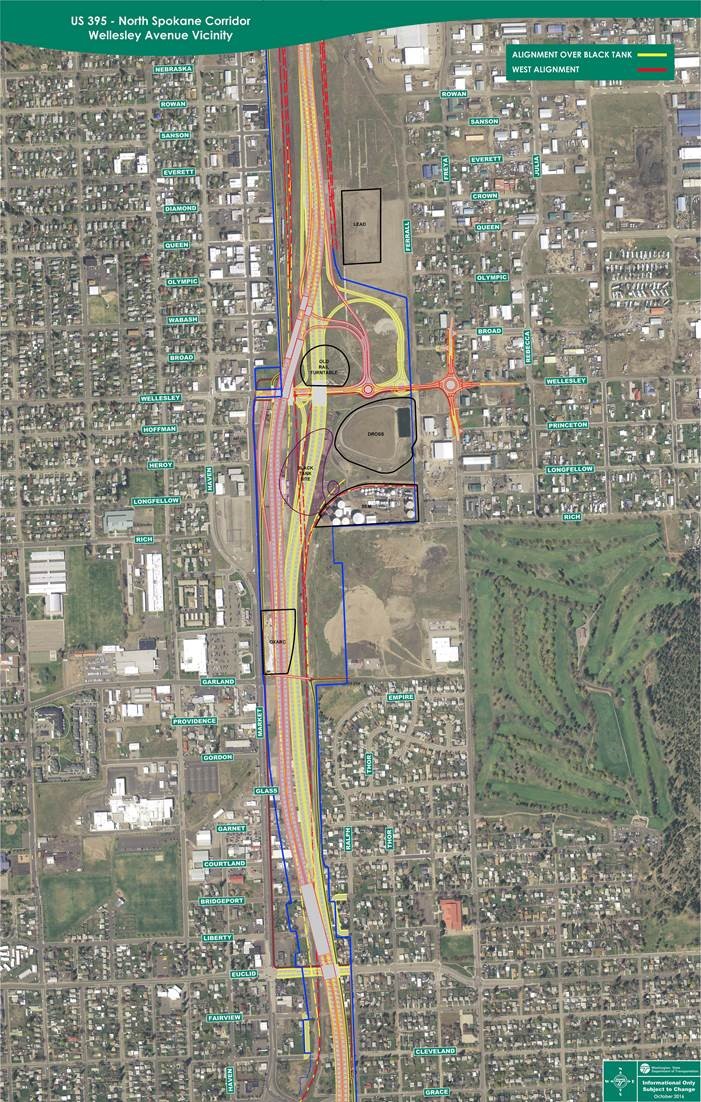After 18 months, an agreement has finally been reached between Burlington Northern Santa Fe (BNSF) Railway, the Washington State Department of Ecology, and the Washington State Department of Transportation (WSDOT) on how to proceed with the clean-up of the Black Tank property in Spokane.
This has been a serious hurdle in the construction of the North Spokane Corridor (also known as the North South Freeway), because the site is in the path of the proposed freeway alignment.
Legislators promised to fully fund and finish the 10.5-mile freeway in the 2015 Connecting Washington Transportation Package – and it’s about time. The project is important to Spokane and has tremendous value for Washington, as we live in the most freight-dependent state in the nation. When finally connected to Interstate 90, the 60MPH freeway will increase freight mobility and improve air quality because trucks will no longer have to travel on local arterials and idle at stoplights. It will also improve safety for pedestrians and drivers who are trying to access schools, parks or shopping centers.
In order for WSDOT to be able to continue with design and construction, an agreement had to be reached about the best freeway alignment for the city, and how to deal with the Black Tank site.
For a little background, the Black Tank site used to contain an enormous black tank that stored petroleum products from about 1910 to 2006, when BNSF removed the tank. According to Ecology, “petroleum products infiltrated soil and groundwater from refueling trains and leaking above-ground storage tanks and associated transfer lines.” The result is a thick, seven-acre plume of bunker-C and diesel fuel “floating on groundwater 170 feet below the ground surface.”
This, too, has been a huge issue for Spokane because the site sits directly over the Spokane Valley-Rathdrum Prairie Aquifer, which is the city’s sole-source of drinking water. Fortunately, the oil is thick, so the contamination stays on top of the groundwater and has not affected the city’s drinking water.
Throughout the public comment period, residents in Spokane communicated a strong preference for a non-elevated design for the freeway due to concerns about “neighborhood aesthetics, the need for more expensive bridges, and infrastructure costs.” The alignment they want – and got - requires coordination with Ecology and BNSF for the environmental clean-up of the Black Tank site.
The agreement that was reached between BNSF, Ecology and WSDOT is a win for everyone involved because it meets the mobility and safety needs of residents, and allows WSDOT to move forward with design and construction on time. The clean-up should begin in 2018.
Congresswoman Cathy McMorris Rodgers (WA-05), Spokane’s federal representative in the US House, released a statement about the agreement, saying:
“Completing the North South Freeway is so important to our region and has long been a priority of mine. I’ll continue doing all I can to ensure this project is on track. After meeting with the WSDOT Secretary Millar and talking to top officials at BNSF, I am pleased to see a framework reached for the environmental cleanup for the ‘Black Tank’ contamination site. I’m committed to bringing together the necessary groups to work through any complications along the way. This agreement will result in a better end product, with the route our community prefers and the environmental cleanup we need. This is an important step forward to Spokane and Northeastern Washington.”
A full timeline of the North Spokane Corridor project can be found here.






